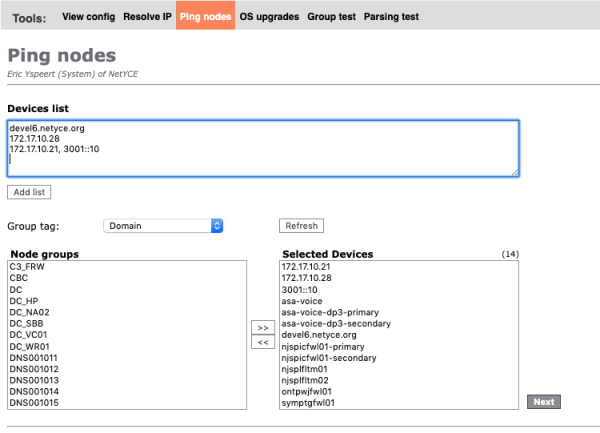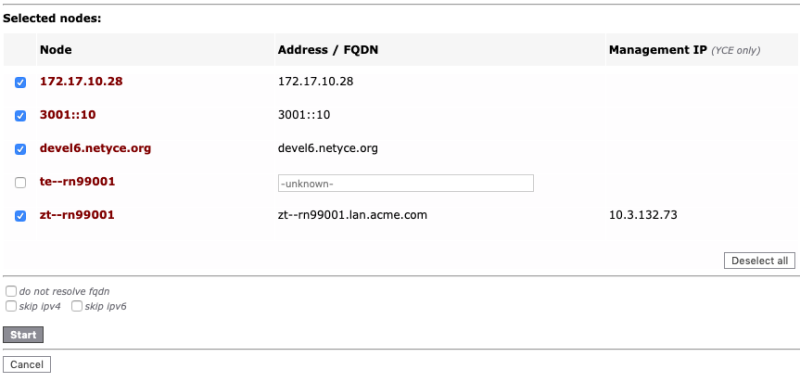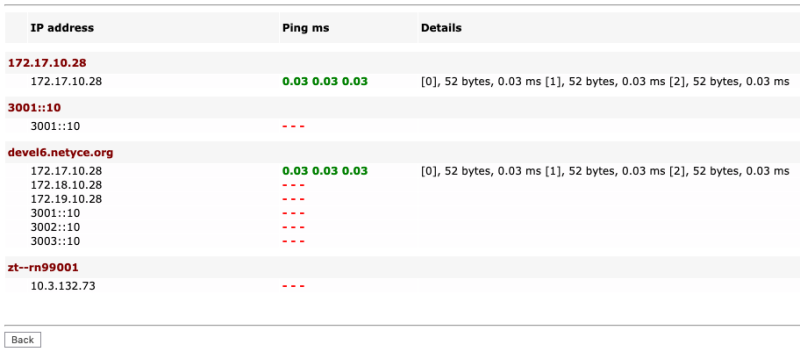Ping nodes
The ping nodes tool enables you to test whether a particular (group of) node(s) is reachable for ICMP using Ipv4 and/or IPv6.
Several means of selecting the nodes to ping exist:
- Select the Node groups from the list and then click
»(or double click) to find all nodes of that group. They will be added to theSelected deviceslist. - Type in the “Devices list” box any number of Node names, Ip-addresses or Full-qualified-names (fqdn) and click on
Add list. This will and add them to theSelected nodeslist. Entries must be separated using comma, space, tab, newline, semicolon or vertical-bar. Ip-addresses may be IPv4 or IPv6.
Both methods can be used in combination. Nodes found from Node groups can be managed YCE or CMDB nodes.

The button « allows entries to be removed from the Selected Nodes list. The Next button takes the user to the next step in the ping wizard: the selection page.

In this step the selection of the nodes and their (ping) details are presented prior to the actual ping. For each entry the validation checks if it is an fqdn, ip-address, an YCE node or a CMDB node. Hostnames can only be resolved if an fqdn is found in the YCE or CMDB database. In case of an YCE node, the configured management IP address is included.
For ip-entries, the ip-address to be used is obvious. For fqdn formatted entries, the fqdn is shown. This fqdn will be resolved against the DNS unless the checkbox “do not resolve fqdn” is set. When an fqdn is resolved ALL its addresses (ipv4 and ipv4) will be pinged.
When a hostname could entry not be located in YCE or CMDB databases, or no fqdn is available, the missing value can be provided ad-hoc. A fqdn or ip-address are valid entries here. The entered value will not be stored.
The initial selection of nodes matches ALL valid node entries, but if a set of nodes was selected using the 'Selected devices“ of the first step, only the valid nodes of this set will be pre-selected.
Remind to set the checkbox for the devices where the address was provided ad-hoc.
When satisfied with the data and the node-selection, click Start to launch the DNS resolving and pinging.

Each of the entries is DNS resolved in sequence and all its resulting ip-address pinged. Every address is pinged tree times. To quickly interpret the results, all successful pings have their response times in n.nn ms shown in green, all failing as a red -. The ping details are included on success.
The Back button returns to the previous page to allow a retry.
This utility uses the fping command to perform the actual ipcm ping. The options used are fping -b 24 -C 3 -r 1 -i 100 -p 500 <addresses> which specifies that three pings are sent 100 ms apart using a 500 ms timeout.